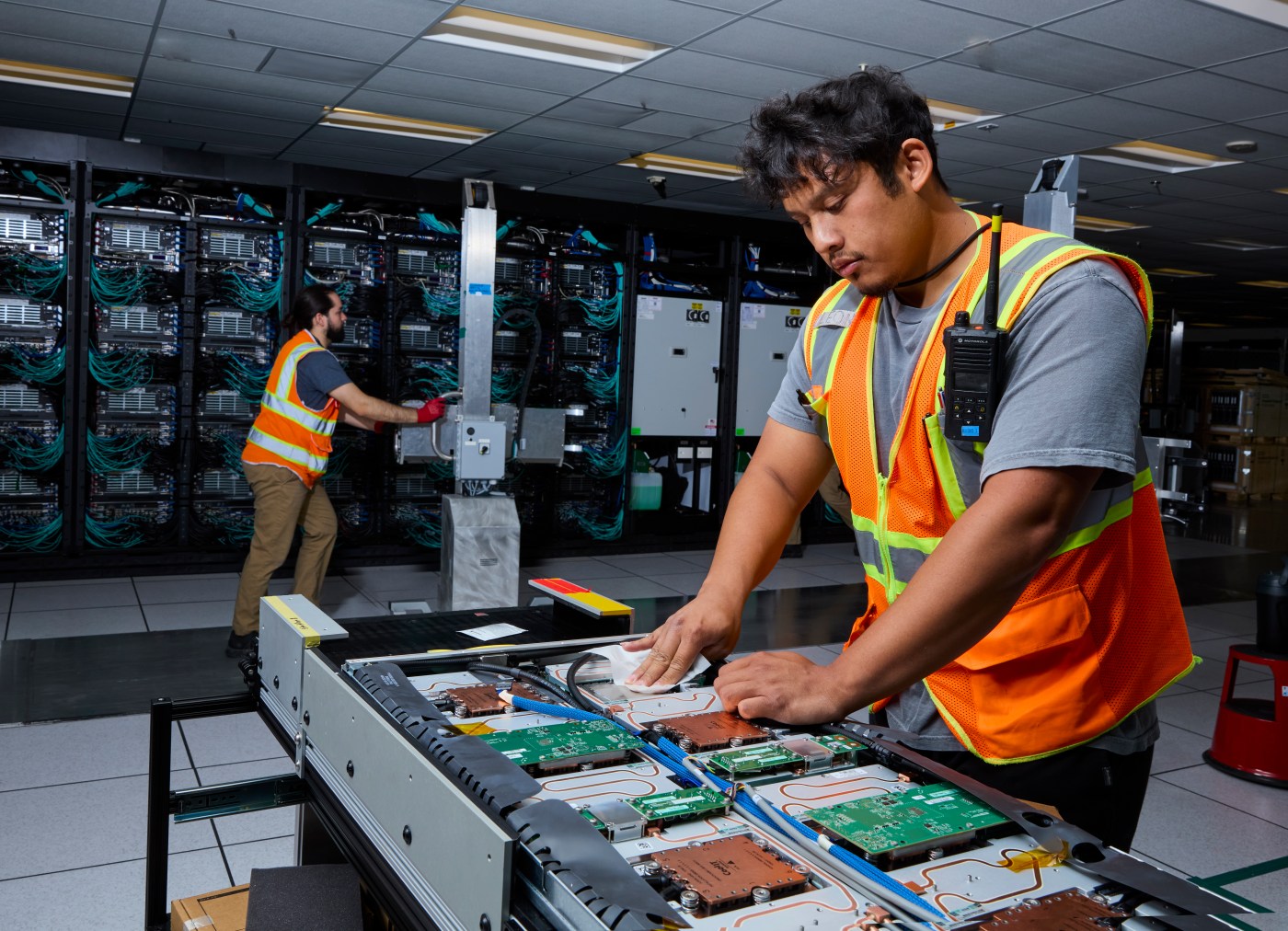The Bay Area has just won a coveted crown in computing, with a massive new machine at Lawrence Livermore National Laboratory deemed the most powerful system in the world.
Meet El Capitan, which churns through data at 1.742 quintillion calculations per second — think 1.7 followed by 18 zeroes — to simulate the testing needed to evaluate the health and extend the lifetimes of America’s nuclear weapons.
That speed record, announced Monday morning, boggles the mind. In human terms, every person on Earth would have to do one calculation every second, for 24 hours a day – for eight years.
Here’s another analogy: It would take a million iPhones working on the same problem at the same time to equal what El Capitan can do computationally in one second. If stacked, those phones would reach five miles high.
“El Capitan is an extraordinary tool that will allow us to continue fulfilling our core mission of ensuring the nation’s security and global stability through the development and application of science and technology,” said Robert Neely, director of the Lab’s Weapon Simulation and Computing Program at the 2024 Supercomputing Conference in Atlanta. “This machine is not just a milestone for supercomputing — it’s a strategic asset for the nation.”
The $600 million behemoth, built by Hewlett Packard Enterprise using chips from Advanced Micro Devices, is the latest chart-topper in the global race to build ever-faster computers. El Capitan has 22 times the computing performance of the lab’s previous most powerful system, named Sierra. Simulations that take weeks or months on Sierra will be done in just hours or days on El Capitan.
“This is necessary for quantifying uncertainties and staying ahead of evolving threats, both from the defense and scientific standpoint — particularly as new materials and manufacturing processes come online,” said Neely.
El Capitan takes the title previously held by the supercomputer Summit, built for the Oak Ridge National Laboratory in Tennessee.
It’s less lovely than its granite namesake. Its brains live in refrigerator-sized units packed into 6,000 square feet of windowless floor space — the size of two tennis courts — inside Building 453, a nondescript tan building protected by the lab’s notoriously strict security. A secret code guards its door.
Continuing a tradition that began with the Sequoia supercomputer at Lawrence Livermore National Laboratory, El Capitan is named after a California landmark – the famed rock formation in Yosemite National Park.
In supercomputing facilities, “you have to have the space, the power, the cooling, and you also have to have the structural integrity of the facility to support the infrastructure,” said Anna Maria Bailey, chief engineer of the Lab’s High Performance Computing. It’s also seismically protected, sitting on plates that shift in response to earthquakes.
At its peak, El Capitan draws 30 megawatts of electricity, enough to power around 30,000 homes in a city about the size of Livermore. Building 453, first built with a standard voltage of 208 volts, was upgraded to 480 volts. Large water pipes provide cooling.
The system is lashed together with long fiber-optic cables. Development and operations engineer Rigo Moreno said that its length, “if we were to lay it out, would be multiple football fields.”
Hewlett Packard Enterprise, which in 2019 purchased the supercomputer pioneer Cray, contributed a networking technology called SlingShot. The system’s special graphics processing chips are made by AMD.
High-performance computing has come a long way since the 1960s, when the Kansas City National Security Campus made history by installing a disk drive that could store 95,000 punch cards worth of data, or approximately 7.6 megabytes.
Supercomputers are now a measure of a nation’s technological prowess.
El Cap’s title comes from its rank on a list called TOP500, which rates the world’s supercomputers based on their ability to solve a dense set of linear equations.
But China may have powerful supercomputers that it has not disclosed in public.
“There are systems, like a lot of classified systems, that are not on the TOP500” list, said Trish Damkroger of Hewlett Packard Enterprise. “If people do not submit, it’s hard to do a comparison.”
Faced with escalating rivalry between the United States and China, the Biden Administration implemented export controls on our nation’s semiconductor chips in 2022.
With a high-performance computer chip made by AMD, the new supercomputer El Capitan is the world’s speediest supercomputer. This will accelerate Lawrence Livermore National Lab’s efforts in nuclear security, as well as efforts in fusion energy, climate research and drug discovery.
El Cap’s key role is to support our testing of our aging nuclear system at Lawrence Livermore, Los Alamos and Sandia National Laboratories. Even as other nations continue to pursue dangerous nuclear agendas, our weapon system is aging.
Not even a bicycle could sit inactive for decades and still be able to spring into action at a moment’s notice. But that’s what is expected of a nuclear weapon, because a 1992 moratorium prevents actual explosions.
“One key advantage of El Capitan,” said Neely, “is that it offers us the ability to run high resolution 3D modeling and simulations that weren’t possible with previous systems — or were computationally too expensive to run on a regular basis, using the accurate physics at the resolutions that we wanted.
“We expect El Capitan to make those runs more commonplace,” he said.
Related Articles
Monterey Bay Aquarium Research Institute discovers mystery mollusc in Monterey Bay
El Palo Alto: How the ‘facts’ around Palo Alto’s famed tree are totally wrong
Opinion: Hacking the planet calls for guardrails and guidelines
RFK Jr. has a long history of promoting anti-vaccine views
At packed UFO hearing, calls for transparency ring loud
The computer will also accelerate research in non-classified fields, according to lab experts.
Supercomputers can be used for earthquake prediction, wildfire modeling and modeling climate change, which means processing huge amounts of data like moisture and wind patterns. They can simulate the behavior of an entire gene of DNA. When the COVID-19 virus appeared, supercomputers were used to help forecast its spread.
“I cannot wait to see what El Capitan allows us to do,” said Judy Hill, project leader of Computational Science at the lab. With its sister machine Sierra, “scientists can do things they could only dream about five to ten years ago.”












